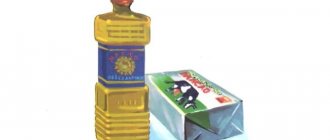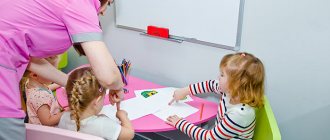Some children have deviations in speech development. If the baby has difficulty pronouncing words or does not speak at all, then it is necessary to work with him and teach him how to communicate with people. The use of an alternative communication system using Pecs cards will help with this. With their help, a child can become a wonderful communicator, even if he is silent.
The main purpose of Pex cards is to provide the baby with the opportunity to ask or express what he wants when he cannot say it in words; they are often used when working with autistic people.
Features of the methodology
Pex cards were invented in the late 1980s by Dr. Andrew Bondy and his assistant.
They were working on a program to correct autism. The goal of the project was to encourage the child to spontaneously begin to communicate and interact. The methodology is based on the principle that the motive for communication must precede the onset of speech. The beginning of the program is to identify potential stimuli for the child, that is, what he likes and desires.
To master Pex, you will need basic skills:
- practice good eye contact, words, gesture symbols “yes”, “no”;
- stable learning skill;
- repeating the “do as I do” actions.
The baby needs to be taught to repeat a cycle of three actions when they are not spoken. Typically this system is intended for children under five years of age. Training is carried out in the form of exercises. Can be used both at home and in special institutions.
Will a child ever speak if he gets used to communicating like this?
The dream of every parent is that the child will be able to express all his needs in words and communicate in detailed and complete sentences. Many are afraid that if children start using such cards, they will not speak. This is a common and very big misconception!
Reviews from parents who have used PECS indicate that with the help of these cards, communication is better stimulated, that is, the child himself wants to communicate and begins to construct sentences in his head. The cards only stimulate him to speak.
Method of working with Pex
For the first exercises, it is best to use images of something loved and dear. It could be an expensive toy, food, hobby, cartoons, or a fairy-tale character. This picture should make the child want to get something that is not always available.
Training stages:
- First, the child must be taught to pick up a picture.
- In the second step, the baby is taught to give the card.
- The third stage involves teaching the child to begin to recognize the objects that are drawn on the plates. Errors that occur at this step lie in the inability to identify the image.
- Then the child needs to be explained how to form sentences like “I want a toy (or something else)”, “Give me...”.
- At the fifth step, the baby is taught to answer the questions “What do you want?”, “What do you see?”
- The final stage involves teaching the child to distinguish objects on the plates, name them independently and answer when asked.
How many PECS cards should I start with?
A child, of course, will not immediately have a whole album of PECS cards. You should start with one motivational or two yes/no cards. If the child understands everything and is quick to learn, another card is added - and gradually their volume is increased to the required size.
You can make PECS cards on the topics: “a trip to grandma’s, “watching cartoons,” “brushing your teeth,” “daily schedules,” “need cards,” etc.
All activity cards must be available so that the child can use them at any time.
Varieties of Pecs
You can make cards yourself, then parents will place selected photographs or pictures on them to make it easier for the child to recognize the images.
Pictures need to be updated periodically, new ones made or purchased. There are many varieties. To begin with, it is better to purchase systematic cards on a particular topic. It can be:
- wild or domestic animals;
- winter clothes - mittens, scarf, hat, mittens, pants, jacket;
- kitchen items - forks, spoons, plates, cups;
- food - fruits, vegetables;
- toys - car, pyramid, doll;
- drinks – tea, coffee, water, soda, compote;
- berries – raspberries, strawberries, blackberries, cherries;
- weather – snow, thunderstorm, sun, rain, hail;
- birds - bullfinch, eagle, parrot, crow;
- actions - going to the store, swimming in the pool, washing;
- prohibitory pictures - that you cannot pick up garbage on the street, talk to strangers;
- to express wishes.
Pex food cards
You can also order individual cards on which any photo will be placed at the customer’s request. People are often asked to depict their favorite pet, pictures of their father, grandmother, or aunt.
Homemade cards: how to make, where to download and buy
You should familiarize yourself with practical recommendations for creating cards at home. What items will you need:
- scissors;
- ruler;
- hole puncher;
- glue;
- Velcro – contact tapes;
- office paper on which pictures will be printed;
- ring binder;
- several plastic or cardboard folders, from which you need to make sheets.
The sequence of creating cards for alternative communication:
- They look for images on their own on the Internet - there are countless of them there. In the search bar you need to type “pecs cards download for free”. The main thing is to choose the right resolution so that when enlarged, there is no grain in the picture.
- Then open the Photoshop program. If it is not there, you can use the standard graphic editor in Windows. To find it, press “start”, “standard”, “paint” in sequence.
- The cards are then printed on a color printer.
- The sheet is glued to cardboard and cut into cards. It is better to laminate them - this way they will last longer. A cheap way is to manually apply the lamination with tape.
- The final step is to cut strips of adhesive tape and glue them to the back of the card.
On the official website you can find Pecs cards of the following categories:
There you can also see a visual schedule for autistic people:
Where can I buy
Pex cards can be purchased in already completed form. Depending on the manufacturer, they may vary, but the meaning is the same. You can purchase not only pictures, but also folders for storing them, and manuals for parents.
In addition to pictures, you can purchase a visual schedule for autism in cards. It will help reduce anxiety and develop the child’s independence. Also, parents often buy certificates of encouragement, which are given to the child for his efforts and success.
Questions and answers
What sizes should you make cards at home?
It’s better to take a size of 4*4 or 5*5; you shouldn’t cut out large pictures.
What images should you start learning with?
It is best to print out what the child loves, what is meaningful and interesting to him. Or start with simple pictures - fruits, toys.
What paper should you use when creating pictures?
It is better to take something denser and thicker so that it is easier for the baby to hold. In addition, be sure to laminate it so that the pictures do not deteriorate for a long time.
How often should classes be held?
One lesson lasts for half an hour. There is no clear plan for how many times a week to exercise. It all depends on the individual characteristics of the child, on his learning skills.
What are Social Stories for Autism in Pictures?
This is part of a visual program that promotes the autistic person's interaction with the world and people around him.
These are short stories shown in pictures. They describe different situations, people's reactions, desired actions that the child should take.
Example of a social story “heating up food”:
“PEKS cards as a means of “triggering” the speech of a non-speaking child. Article on correctional pedagogy
“PEKS cards as a means of “triggering” the speech of a non-speaking child.
HAPPINESS IS WHEN YOU ARE UNDERSTOOD! Have you ever wondered what communication is? What role does it play in our lives? How important is it for you and your child? So what is communication? The following picture immediately comes to mind: two people sitting next to each other and talking. However, communication is not just a conversation, but an exchange of information. This is an opportunity to convey to another your thoughts, desires, and express a request. In our usual understanding, the exchange of information occurs through words. But what if the ability to express your feelings and desires using words is not available? If a child doesn’t speak, how can you help him say everything he really wants to express?
The main problem of children with special needs is that they cannot speak and express their needs. If parents can still somehow understand what their child wants, then when communicating with strangers, non-speaking children have difficulties - they often do not understand them, as a result of which the child begins to get nervous, freak out, and show aggression.
The question arises: how to communicate with a nonverbal child?
Such children need special teaching materials, without unnecessary details - cards and visual schedules, with the help of which the child can communicate with other people.
Pex system This is a system that allows a child with speech impairments to communicate by exchanging cards. It is in the exchange of cards, and not just in their use.
The abbreviation PECS stands for Image (Card) Exchange Communication System. The system was developed in America in 1985. Initially created for children with autism spectrum disorders. Andy Bondi and Laurie Frost. And this is a very well-structured system that is taught in American universities. It is official for them. It is used very widely for various people suffering from speech disorders. There is a book, translated into Russian, which can be used to teach this system.
It was originally created for children with ASD. But as it turns out, this system is suitable for absolutely all children who have difficulties with speech and communication.
These materials help achieve success in the development of non-verbal children who have autism, hearing loss, mental retardation, cerebral palsy, etc. and often become a necessary means of communication in their adult lives.
Cards make it much easier for children to understand speech; the level of anxiety in children with racial backgrounds is significantly reduced, and children become more independent. The alternative communication system using PECS cards solves the priority problem of “triggering” the speech of a non-speaking child.
Children with disabilities have difficulty initiating various actions, even their own messages and requests. Because of this, most will prefer to wait for someone to ask, sooner or later, “what do you want?” or uses some alternative communication system. The task of PECS is to teach how to start communication, to voice your opinion, need or desire on your own initiative.
The development of any communication skills significantly increases the likelihood that a child with disabilities will begin to use oral language. If the child is still not proficient in it, then the PECS system will help him learn to use an alternative method of communication in situations where “words are not enough.”
Over the years of using PECS, it has been found that the use of this alternative communication system can significantly improve spoken language over time. Quite often, children with disabilities stop using cards at some point as they develop regular speech - a simpler and more effective way of communication compared to exchanging images. During PECS classes, children work: learn, learn, think. PECS is the voice of the child.
In the purchased version they are presented in a fairly extensive volume. If you want to make PECS cards yourself, you can download ready-made sets of pictures presented on various Internet resources.
In addition, you can make your own unique set by selecting any pictures you like from materials available at home (old printed publications, packaging from children's things, etc.).
So, PECS cards are pictures depicting both objects (even the most ordinary household items: dishes, food, toys, etc.) and actions: brushing teeth, getting dressed for the street, time for studying. In addition, cards can serve as a reminder to prohibit any actions. For example, a ban on picking up something on the street. Cards for expressing wishes are also relevant. A child does not begin to use them right away and, as a rule, only if he already knows how to read, since they are often accompanied by the inscription “I want,” etc. The child, of course, will not immediately have a whole album of PECS cards. You should start with one motivational or two yes/no cards. If the child understands everything and is quick to learn, another card is added - and gradually their volume is increased to the required size. You can make PECS cards on the topics: “a trip to grandma’s, “watching cartoons,” “brushing your teeth,” “daily schedules,” “need cards,” etc.
All activity cards must be available so that the child can use them at any time
A prerequisite for starting a child’s education using the PEX system is to develop in him a desire to receive or do something. In order for a child to take initiative in communication, he must want to communicate. The child must want some object and perform some action.
The method is based on the fact that the reason for communication must precede the actual speech activity. The method begins with identifying potential stimuli (what the child likes and wants).
Basic necessary skills to start mastering PECS: practicing relatively stable eye contact, words or gestures “yes”, “no”, “give”; sustainable study skill; imitation of “do as I do” actions. The child should be able to repeat a series of simple 2-3 actions when the actions are not named.
As a rule, children under five years of age are introduced to this system. In order to successfully master the alternative communication system of image exchange, the following six stages of training are carried out sequentially.
THERE ARE 6 STAGES OF PECS TRAINING AND ALSO A SUBSTAGE RELATED TO THE USE OF ADDITIONAL SKILLS.
The time required to complete each stage depends on the individual child and can take from one introductory lesson to several training sessions.
The main goal of the first stage of PESS training is to teach the child to give a card to his communicative partner in order to get the item he wants. That is, when a child sees a motivational stimulus, he takes a picture, hands it to an adult, and leaves the picture in the teacher’s hand. At this stage of training, two adults are present.
One of the adults, the “communication partner,” sits opposite the child and holds in his hands the object that the child wants to receive. The second adult - the “fairy” - sits behind the child and physically guides the child’s hand to the picture, helps him take the picture and hand it to the “communication partner”. It is important that both adults remain silent. The “communication partner” can bring the desired object closer to the child in order to encourage his initiative, but without words. The second adult (“fairy”) must carefully monitor the child’s movements, and as soon as the child begins to reach for the object, guide his hand to the card, and help him take the card, and hold it out - and all this is also silent. When the child places the card in the hand of the “communication partner”, only then does the “communication partner” pronounce the name of this item and immediately give it to the child. With this action, the “communication partner” voices the child’s request, and in the future, if the child learns to imitate words, he will be able to accompany the request with words.
You can move on to the second stage if the child has learned to submit from 10 to 24 cards, and does this independently and without the physical prompting of the “fairy”. At the second stage, as at the first, there is no choice. That is, there is only one card in front of the child, and only one object. And just like at the first stage, verbal prompts are not used. But, if at the first stage the child was only required to present a card, then at the second stage the child is required to have a more complex reaction. For example, take a card, get up from the table, and approach an adult, put the card in his hand. Or, the child is in the space and not at the table. He saw that the adult was holding the desired object in his hands - the child went to the table, took a card and, together with the card, approached the adult. The “fairy’s” task here is to physically guide the child to the card, or to a partner if the child loses concentration and cannot do it on his own.
The second stage of PESS training never stops. That is, for any newly introduced card you need to work out all the options and make sure that the child can bring this card in any situation.
Stage 3 is called distinguishing cards. It is this stage that will help to understand whether the child distinguishes the images on the card. We get several cards at once, but only one desired item. And the child must choose exactly what he wants. For example: bananas are very tasty, he must give the card and receive a banana in return. The child has learned that the use of cards has an impact on others, and that with the help of cards he can get what he wants - it is time to teach the child to distinguish the symbols that he uses to communicate.
Learning to distinguish cards occurs precisely at the third stage, when primary communication skills have already been established. Ultimately, the child must learn to choose the card of the desired item from all the cards that are in his communication book. During training, it is important to constantly change the cards so that the child is more attentive and does not get used to giving only the left or only the right card.
The main goal of the fourth stage is to complicate the reaction. If previously the child gave only one card to ask for the desired action or object, now the child learns to put several cards into a sentence. That is, attach several cards in the required order to a strip of tape and serve this strip.
The end result expected from the child is the following - the child asks for objects that are or are not in the field of view using a phrase consisting of several words. He opens the book, finds the “I want” symbol, sticks it on a strip, finds an image of an object, sticks it on the strip, tears the strip from the book, approaches the communicative partner, and gives this strip. By the end of this stage, the child should be able to use 20 or more different cards and address different partners.
Thus, the child must learn to ask for objects and actions that are in his field of vision, as well as for absent objects.
In order to teach this skill, it is necessary to check which characteristics of favorite objects stand out to the child. If your child prefers only red candies and is not interested in blue and green candies, then you can start working on the adjective “red.” If the child is not interested in colors, then you can look for other characteristics - sizes, shapes, prepositions or body parts.
At the fifth stage, the main goal is to teach the child to respond to the question “What do you want?” That is, only at the fifth stage, after the child’s initiative has been consolidated, can the child be taught to respond to a question. Why only now? In order to teach the child to listen to his own desires, and not just react and be led by others. Many children with disabilities find it difficult to take initiative and approach others, and if you initially teach the child to only respond to the question “What do you want?” - this can significantly suppress initiative, and, consequently, the further development of social skills and communication.
Well, the last 6th stage is called commenting, when our child independently, spontaneously, together with an adult, comments on the world around him, what is happening to him. You can answer various questions, enter into dialogue, that is, for example: with us we can listen to some kind of music and the child can tell us that he is listening to a violin or drum, we can work as a speech therapist, speech therapist or psychologist. Again, without uttering a word, if the child cannot do it, but at the same time he will tell us about what he sees, what he hears, answer questions, what is it there, what colors are it or how much of it and we have all this will occur at stage 6 of commenting. If by that time the child’s speech has not begun to develop and we understand that it will not exist, or it will be very limited. PECS will be his only type of communication; alternative communication is the type of communication we will work with.
Parents' opinion
I ordered the first cards for autism through Planik.
The images on them are first-class, there is no blur, everything is clear and there are no small details. This is important for special children. I bought cards with the theme "Pets". I am very pleased with the quality - they are dense and do not tear. Well, the result is amazing, our son’s success makes us happy. We'll take it again, it's an excellent technique. For those who do not have the opportunity, the cards can be downloaded for free via the Internet. Elena, 27 years old, Kaluga
Hello! I want to share our little joy with you. We have been buying cards for several years now. The daughter successfully remembers words and gradually learns to compose sentences and phrases. He even makes up little stories. And the quality is very good, all the pictures are laminated, they don’t come apart, they don’t even bend. My respect and bow to the creators of this technique.
Alina, 36 years old, Moscow
What results can be achieved
Using Pex allows you to achieve the following results:
- This program will help you quickly develop communication skills in a short time.
- The method promotes the child’s development of initiative, its expression, and spontaneous pronunciation of words and phrases.
- Communication and contact with people around you will become more accessible. Subsequently, the baby can be helped to generalize the acquired verbal means of communication.
- The use of Pecs cards does not interfere with spoken language, but, on the contrary, accelerates its emergence and development. This is achieved by parrying verbal and visual stimuli in an exchange process.
No significant disadvantages were noticed; the effectiveness of the system was confirmed by the National Center for Professional Development.
Autistic people are not lazy to speak; they want to communicate with family and friends, but do not know how to do this. Therefore, an alternative program to help develop speech is available to many parents and their children.
What is PECS
The main problem of children with special needs is that they cannot speak and express their needs.
If parents can still somehow understand what their child wants, then when communicating with strangers, children with autism spectrum disorder have difficulties - they are often not understood, as a result of which the child begins to get nervous, freak out, show aggression, etc. The question arises: how to communicate with a nonverbal child? Article on the topic: Basic rules for teaching an autistic child
Such children need special teaching materials, without unnecessary details - cards and visual schedules, with the help of which the child can communicate with other people.
PECS is an alternative communication system using card exchange, which was originally created for children with ASD. But as it turns out, this system is suitable for absolutely all children who have difficulties with speech and communication.
These materials will help achieve success in the development of non-verbal children (autism, hearing loss, mental retardation, cerebral palsy, etc.), and often become a necessary means of communication in their adult lives.
![Visual and didactic manual on sound automation [C] “Interesting cards”](https://pleshakof.ru/wp-content/uploads/naglyadno-didakticheskoe-posobie-po-avtomatizacii-zvuka-s-interesnye-kartochki-330x140.jpg)







